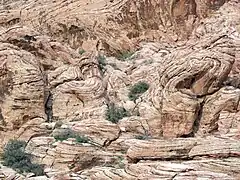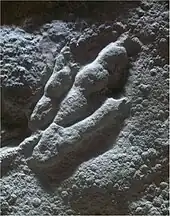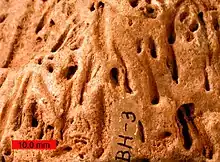| Aztec Sandstone | |
|---|---|
| Stratigraphic range: Early Jurassic | |
 Outcrop of the Aztec Sandstone at Red Rock Canyon National Conservation Area near Las Vegas, Nevada | |
| Type | Sedimentary |
| Underlies | Willow Tank Formation[1] |
| Overlies | Chinle Formation |
| Area | Nevada,[2] Arizona, California[3] |
| Thickness | 2,100 ft (640 m) in Goodsprings quadrangle[2] 2,500 ft (760 m) in Muddy Mountain area[1] |
| Lithology | |
| Primary | sandstone |
| Other | arenite, sand |
| Location | |
| Coordinates | 35°24′N 115°30′W / 35.4°N 115.5°W |
| Approximate paleocoordinates | 20°48′N 53°24′W / 20.8°N 53.4°W |
| Region | Mojave Desert |
| Country | |
| Type section | |
| Named by | D. F. Hewett[2] |
| Year defined | 1931 |
 Aztec Sandstone (the United States)  Aztec Sandstone (California) | |
The Aztec Sandstone is an Early Jurassic geological formation of primarily eolian sand from which fossil pterosaur tracks have been recovered.[4] The formation is exposed in the Mojave Desert of Arizona, California and Nevada. Aztec Sandstone is named after the Aztec Tank,[5] a lake in the Spring Mountain region of Nevada.
Description
The Aztec Sandstone is made up of two units. The lower resistant sandstone unit (100 metres (330 ft) thick) is tan to off-white in outcrops but pinkish in fresh exposures. Crosbedded lenses can easily be observed. Frosted and pitted quartz grains well-cemented by silica are described by Evans in 1958 and 1971. The upper and less resistant unit (200m thick) consists of alternating white quartz arenites and red to brown silty sands.[6]
Vertebrate paleofauna
The formation has provided the following ichnofossils attributed to vertebrates:[4]
| Ichnofossils of the Aztec Sandstone | ||||||
|---|---|---|---|---|---|---|
| Genus | Species | Location | Member | Abundance | Notes | Images |
| Anchisauripus[7] | Reclassified as Grallator | |||||
| Brasilichnium | ||||||
| Grallator[8] |  | |||||
| Navahopus | ||||||
| Octopodichnus | ||||||
| Pteraichnus[9] | ||||||
| Skolithos |  | |||||
Color key
|
Notes Uncertain or tentative taxa are in small text; |
See also
References
- 1 2 Longwell, C.R. (1949). "Structure of the Northern Muddy Mountain Area, Nevada". Geological Society of America Bulletin. 60 (5): 923–968. Bibcode:1949GSAB...60..923L. doi:10.1130/0016-7606(1949)60[923:SOTNMM]2.0.CO;2. ISSN 0016-7606. Wikidata Q60182382.
- 1 2 3 Hewett, D.F. (1931). "Geology and ore deposits of the Goodsprings quadrangle, Nevada" (PDF). Geological Survey Professional Paper (162). doi:10.3133/PP162. ISSN 0096-0446. Wikidata Q61823480. (incl. geologic map, scale 1:62,500)
- ↑ Jennings, C.W., 1961, Geologic map of California; Kingman sheet: California Division of Mines and Geology, scale 1:250,000
- 1 2 Aztec Sandstone at Fossilworks.org
- ↑ "Geolex — Aztec publications". ngmdb.usgs.gov. Retrieved 2023-03-14.
- ↑ Mescal Range at Fossilworks.org
- ↑ Listed as "cf. Anchisauripus" in "Appendix: Summary of the Mesozoic Reptilian Fossils of California," Hilton (2003) p. 265
- ↑ Listed as "cf. Grallator" in "Appendix: Summary of the Mesozoic Reptilian Fossils of California," in Hilton (2003) p. 265
- ↑ Lockley, et al. (2008)
Bibliography
- Bonde, J. W.; Varricchio, D. J.; Jackson, F. D.; Loope, D. B.; Shirk, A. M. (2008). E. M. Duebendorfer; E. I. Smith (eds.). Dinosaurs and dunes! Sedimentology and paleontology of the Mesozoic in the Valley of Fire State Park. Vol. 11. pp. 249–262. doi:10.1130/2008.FLD011(11). ISBN 978-0-81-375611-0. Wikidata Q95597606.
{{cite book}}:|journal=ignored (help) - Lockley, M.; Harris, J.D.; and Mitchell, L. 2008. "A global overview of pterosaur ichnology: tracksite distribution in space and time." Zitteliana. B28. p. 187-198. ISSN 1612-4138.
- Porter, M.L. (August 1987). "Sedimentology of an ancient erg margin: the Lower Jurassic Aztec Sandstone, southern Nevada and southern California". Sedimentology. 34 (4): 661–680. Bibcode:1987Sedim..34..661P. doi:10.1111/J.1365-3091.1987.TB00793.X. ISSN 0037-0746. Wikidata Q97000543.
- Hilton, Richard P. 2003. Dinosaurs and Other Mesozoic Reptiles of California. Berkeley: University of California Press. 318 pp.
Further reading
- R. E. Reynolds. 1986. California trackways from the Lower Jurassic Aztec Sandstone. In D. D. Gillette (ed.), First International Symposium on Dinosaur Tracks and Traces. Abstracts with Program 24